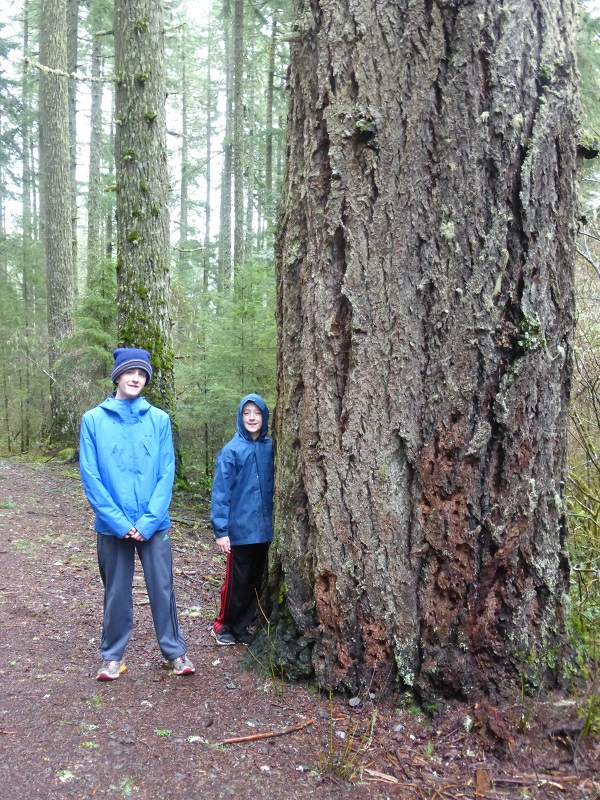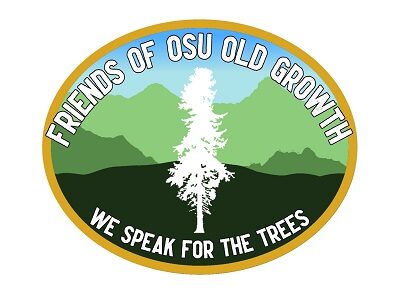(This piece originally appeared in the Corvallis Advocate on July 17th, 2019)

In May of 2019, Oregon State University’s College of Forestry harvested ~16 acres of old-growth forest near Baker Creek, north of Corvallis. Scores of 200-300 year-old trees were cut. An adjacent ~36 acres of old-growth forest near Sulphur Springs is still allocated as part of OSU’s “future harvest program.” The cutting of these trees violates the College of Forestry’s own guiding principles (protecting Old Growth). The Dean of the College of Forestry has now characterized it as a “mistake,” and has vowed to change their management practices.
They stood for centuries, stately sentinels on guard, withstanding fire and countless storms. The Kalapuya surely knew and revered them. Settlers in the 1800’s sought their moss-covered shade on warm summer days. Early citizens of Corvallis saw them when they traveled by horse and buggy to visit the adjacent Sulphur Springs. Generations of OSU foresters and faculty knew they were special – and kept them from harm.
More particularly, one family saw them and decided to call our valley home. Another hugged them with her daughters, now grown to adults. I must have run and biked past them hundreds of times in the past three decades, and led my son’s preschool class on a field trip to see them: these Old Growth giants now cut for lumber and pulp.
One of these trees, a “mere” 44-inches in diameter (many were much larger) was verified to be 420 years old. It’s a painstaking process, counting growth rings with a 10x eyepiece and needle, 50 rings per inch in the densest sections. When finished, it takes awhile for one’s sight to recover from squinting. This tree sprouted around 1599, twenty years before the Pilgrims landed, and 270 years before OSU was founded. At 100 years of age, it wasn’t quite 12 inches in diameter – a sign that it started its life in the shade of even older trees. The surrounding grove was home to northern spotted owls. These birds recognized something special here, far beyond their normal habitat.

For roughly 14 generations, this tree thrived in the forest near Corvallis, one in a grove of dozens of old trees. Then, one day, two veteran OSU foresters decided the trees should be cut.
“Signs of increased mortality in the stand,” one wrote to justify his decision (though no evidence has yet been presented to support this claim).
Recent aerial photos show healthy, green crowns throughout the stand of trees. Nearly all of the stumps are sound and free of rot. OSU’s own forestry experts tell me it’s exceedingly rare to see widespread mortality in our old-growth forests.
Even if some (younger) trees were dying, why take the healthy giants? OSU’s own Research Forest Plans aimed to “protect special features such as old-growth Douglas-fir stands,” and did not allow for “salvage of standing dead or downed trees… and operational activities that harm old trees or change the character or function of the old growth stand.” Cutting these trees was in clear violation of OSU’s own guiding principles.

Both of the OSU foresters involved in this decision are described as “good people,” recipients of various awards. They are part and parcel of the College of Forestry’s hierarchy and culture. Years from now, both will likely retire from OSU with nothing more than a minor rebuke for their actions. What does this say about OSU and the College of Forestry, both public institutions? What does it say about our society when we allow our public institutions to manage these priceless natural assets, our ecological heritage, with such wanton disregard.
Make no mistake, this is not a small or recent development. The College of Forestry abandoned their Research Forest Plan a decade ago, a plan that had received widespread acclaim and support. Even though the plan did not allow for collaboration with public stakeholders, it considered our input and made a sincere effort to protect special ecological features of the forest such as Old Growth. With the last update 14 years ago, and the plan long since suspended, the current problems are not unexpected. When you don’t have a plan, accountability is one of the first things to go.
Forest economists can calculate the lost profit and productivity of keeping an Old Growth tree in their forest plantations. They can calculate exactly how much the 6-8 younger trees, grown on a 40-year rotation, will earn for the College of Forestry. But can they calculate the much greater loss to society when trees like this are cut? Impacts to property values and attitudes of recreational users is only a tiny part of the cost. Ecosystem functions, like clean air, water, cooling effects, and carbon sequestration are not even considered in our accounting or tax systems. The northern spotted owls were viewed as “irrelevant” by a former Dean, an irritant of no value. How would an economist price OSU’s now-tarnished reputation, or their loss of credibility, when they are caught cutting Old Growth in violation of their own principles and society’s norms?
My teenage son once considered studying forestry at OSU. Seeing the destruction of the Old Growth changed his mind and turned both of my boys into fledgling eco-warriors. Multiply this by 100 or 1000 more young people, and the people in power start to worry. I am but one voice, but I speak for many who share my views. I speak for the trees that were cut – and for the future generations who’ve been robbed of this priceless natural heritage. These trees were not yours to destroy!

Baker Creek old growth – before OSU’s forest managers decided to cut it
By Doug Pollock
